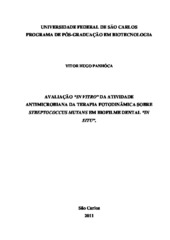| dc.contributor.author | Panhóca, Vitor Hugo | |
| dc.date.accessioned | 2016-08-17T18:39:39Z | |
| dc.date.available | 2011-10-17 | |
| dc.date.available | 2016-08-17T18:39:39Z | |
| dc.date.issued | 2011-07-26 | |
| dc.identifier.citation | PANHÓCA, Vitor Hugo. Avaliação in vitro da atividade antimicrobiana da terapia
fotodinâmica sobre Streptococcus mutans em biofilme denteal in situ . 2011. 74 f. Dissertação (Mestrado em Multidisciplinar) - Universidade Federal de São Carlos, São Carlos, 2011. | por |
| dc.identifier.uri | https://repositorio.ufscar.br/handle/ufscar/6984 | |
| dc.description.abstract | The Photodynamic Antimicrobial Chemotherapy (PACT) has shown that is a promising alternative for buccal disinfection. The objective of this in situ work is to investigate the antimicrobial effect of photodynamic therapy over biofilms by the use of curcumine and Photogem® presented in a solution. In this research 18 volunteers were selected randomly from both sexes, with age over than 18 years. These patients wore a removable palatine device that contained six enamel/dentin specimens of 5 square millimeters by 2 millimeters of thickness. Those patients wore those devices during the period of four days, after that the biofilm created over the specimens were treated using different PACT protocols. The effect of the PACT treatments was evaluated by the microbial reduction of the Streptococcus mutans by UFC counting. This study compared a control group with the curcumine group that didn't received light irradiation with another group that was treated with the PACT protocol using curcumine solution, and other group that used the photosensitizer presented in solution with Photogem®. The obtained results of this investigation showed the reduction of the amount of the S. mutans UFC. The highest reduction (p=0.02) was observed when the PACT is applied with solution using Photogem as the photosensitizer. In conclusion, this study suggests that there is a antimicrobial effect of photodynamic therapy over biofilms by the use of curcumine (1.500μg/mL) and Photogem® (1.000μg/mL) followed by LED system irradiation (λ=640±5nm). | eng |
| dc.description.sponsorship | Universidade Federal de Sao Carlos | |
| dc.format | application/pdf | por |
| dc.language | por | por |
| dc.publisher | Universidade Federal de São Carlos | por |
| dc.rights | Acesso Aberto | por |
| dc.subject | Terapia fotodinâmica | por |
| dc.subject | LED | por |
| dc.subject | Streptococcus mutans | por |
| dc.subject | Microbiological analysis | eng |
| dc.subject | LED | eng |
| dc.subject | Photochemotherapy | eng |
| dc.subject | Streptococcus mutans | eng |
| dc.title | Avaliação in vitro da atividade antimicrobiana da terapia
fotodinâmica sobre Streptococcus mutans em biofilme denteal in situ | por |
| dc.type | Dissertação | por |
| dc.contributor.advisor1 | Kurachi, Cristina | |
| dc.contributor.advisor1Lattes | http://lattes.cnpq.br/0194007981724312 | por |
| dc.description.resumo | A Terapia Fotodinâmica (TFD) antimicrobiana tem se mostrado uma promissora alternativa para a desinfecção bucal. Os objetivos deste trabalho in situ foram de investigar o efeito antimicrobiano em biofilme dental por meio da TFD, utilizando-se bochecho e aerosol contendo, respectivamente, curcumina e Photogem®. Nesta pesquisa, foram selecionados 18 voluntários de ambos os sexos, com idade acima de 18 anos e de forma aleatória na população. Esses voluntários usaram uma placa contendo blocos de esmalte bovino, durante 4 dias. Após a formação de biofilme dental sobre a superfície dos blocos, as amostras foram submetidas ao tratamento com TFD. O efeito da TFD foi avaliado pela redução de Streptococcus mutans em meio de cultura Mitis Salivarius com Bacitracina e sacarose. Os grupos experimentais investigados foram, Grupo II: tratado com solução de curcumina (1.500μg/mL); Grupo III: tratado com TFD (λ=450±5nm) e solução de curcumina (1.500μg/mL); Grupo IV: que recebeu TFD (λ=640±5nm) com solução contendo Photogen® (1.000μg/mL) comparados com o grupo controle(Grupo I), o qual não recebeu tratamento. Os dados resultantes obtidos foram submetidos ao teste de análise estatística ANOVA a nível de 5% (p<0,05). A análise estatística mostrou que houve redução significativa na quantidade de S. mutans no grupo tratado com a curcumina + luz (p=0,04) e no grupo com Photogen® + luz (p=0,02). Ocorreu redução de S. mutans quando comparamos o Grupo I com os demais grupos experimentais, nas seguintes proporções: 8% para o Grupo II, 15% para o Grupo III e 18% para o Grupo IV. Em conclusão, sugere-se que há efeito antimicrobiano em biofilme dental por meio da TFD quando do uso de solução de curcumina (1.500μg/mL) e ou de Photogen® (1.000μg/mL) seguidos da irradiação com sistema LED (λ=640±5nm). | por |
| dc.publisher.country | BR | por |
| dc.publisher.initials | UFSCar | por |
| dc.publisher.program | Programa de Pós-Graduação em Biotecnologia - PPGBiotec | por |
| dc.subject.cnpq | CIENCIAS BIOLOGICAS | por |
| dc.contributor.authorlattes | http://lattes.cnpq.br/6145200370366650 | por |
